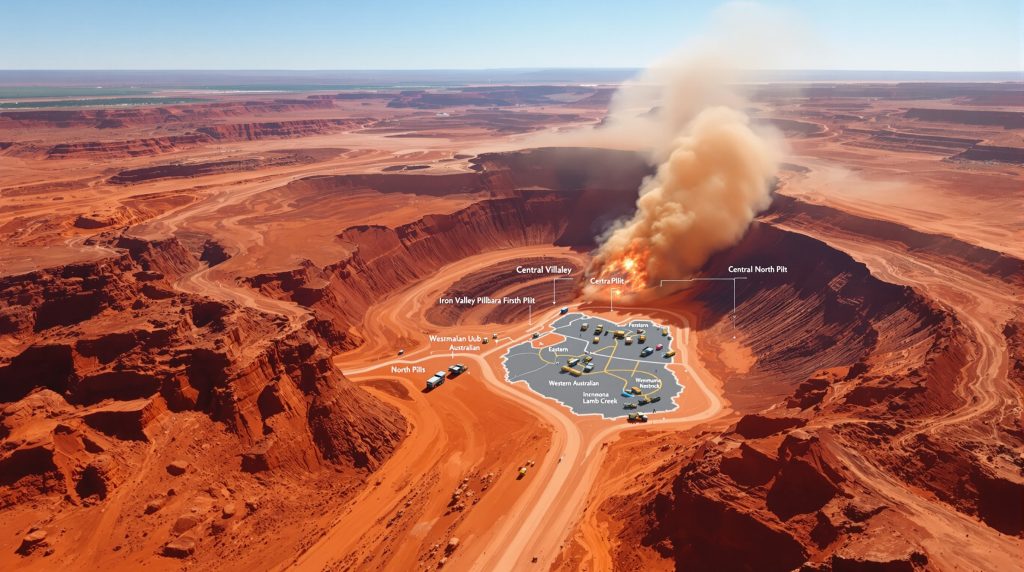What is the Iron Valley Mine and Why is This Milestone Significant?
Iron Valley stands as a cornerstone in Mineral Resources Limited's (MinRes) iron ore portfolio, holding the distinction of being the company's oldest continuously producing iron ore operation. Located 75 kilometers northwest of Newman in Western Australia's resource-rich Pilbara region, this established mine has recently reached a pivotal milestone with the successful first blast at its North Pit development.
The significance of this expansion cannot be overstated, as it represents a strategic broadening of the mine's operational footprint beyond the existing Eastern and Central Pits. This development ensures continued production capacity at this foundational asset while strengthening MinRes' position as a key player in the competitive Pilbara iron ore landscape.
According to Joe Brown, MinRes Central Pilbara General Manager, this development represents "another important milestone for our Central Pilbara team, who has enjoyed a successful year." The expansion comes at a strategic time for the company as it continues to consolidate its iron ore operations in the region.
The North Pit development isn't merely an incremental addition but rather a calculated move to ensure the long-term sustainability of one of MinRes' most established operations. By expanding into previously untapped areas of the deposit, the company demonstrates its commitment to maximizing resource recovery while extending the productive life of this foundational asset.
How Does the North Pit Expansion Fit into MinRes' Central Pilbara Strategy?
The Central Pilbara Hub Structure
The Iron Valley operation serves as a critical component within MinRes' broader Central Pilbara hub strategy, which integrates three strategic mining operations into a cohesive production network:
- Iron Valley – The company's longest-operating iron ore mine
- Wonmunna operation – A complementary asset in the Central Pilbara portfolio
- Lamb Creek site – The third key component completing the hub structure
This three-site configuration creates a robust and diversified production network with an impressive combined capacity of 10 million tonnes per annum (Mtpa). This substantial output establishes MinRes as a significant presence in Western Australia's iron ore sector, particularly in the Central Pilbara region.
The hub concept represents a sophisticated approach to resource development, allowing for operational synergies that wouldn't be possible with isolated mine sites. By treating these three operations as interconnected components of a larger system, MinRes can optimize everything from equipment utilization to logistics planning.
Production Capacity and Integration Benefits
The Central Pilbara hub's integrated approach delivers multiple strategic advantages that enhance MinRes' competitive position:
- Operational efficiency maximization – Shared resources and expertise across multiple sites reduce overhead costs
- Streamlined logistics systems – Coordinated transportation planning optimizes the movement of ore to port
- Production level consistency – The ability to balance output across three operations helps maintain steady supply
- Ore quality management – Sophisticated blending capabilities ensure consistent product specifications
This hub-based strategy exemplifies modern resource sector approaches to value maximization. Rather than operating mines as independent entities, the integration creates economies of scale and operational flexibilities that drive improved returns on investment. The North Pit development at Iron Valley enhances the hub's overall resilience by expanding its resource base.
Industry analysts note that this integrated hub approach has become increasingly common among mid-tier miners seeking to compete effectively with the major players in the Pilbara region. By consolidating operations geographically, companies like MinRes can achieve many of the scale advantages of larger competitors while maintaining the agility of smaller operations. This approach represents a strategic response to mining industry consolidation trends seen across the sector.
What Technical Achievements Led to the North Pit Development?
Targeted Drilling Program Completion
Prior to the successful first blast at North Pit, MinRes completed an extensive targeted drilling program at the location. This preparatory work established the foundation for the expansion through several critical functions:
- Precise ore body definition – Detailed drilling mapped the boundaries and characteristics of the deposit
- Optimized blast pattern design – Scientific analysis determined the most efficient explosive placement
- Environmental impact minimization – Careful planning reduced the ecological footprint of blasting activities
- Comprehensive safety planning – Thorough geotechnical analysis ensured worker protection during operations
The drilling program represents a significant investment in technical understanding of the North Pit resource. By gathering detailed geological data before proceeding with development, MinRes positioned itself to maximize resource recovery while minimizing operational risks.
Modern drilling techniques employed in programs like this typically include reverse circulation and diamond core drilling, providing samples that undergo rigorous laboratory analysis. This scientific approach to resource definition stands in stark contrast to the more intuitive methods used in earlier mining eras.
Strip Activities Preparation
Following the successful initial blast, the North Pit site is now undergoing systematic strip activities—the crucial process of removing overburden material to access the valuable iron ore deposits beneath. This phase encompasses:
- Methodical non-ore material removal – Careful excavation of the layers covering the iron ore deposit
- Strategic waste rock management – Segregation of overburden into categories based on potential future value
- Haul road and infrastructure establishment – Development of transport routes to integrate with existing operations
- Environmental control systems implementation – Installation of drainage and sediment management structures
These preparatory activities create the essential groundwork for efficient ore extraction once the pit reaches its production phase. The strip ratio—the amount of waste material removed per tonne of ore—represents a critical economic factor in open pit mining operations like Iron Valley.
Industry standards for iron ore operations in the Pilbara typically involve strip ratios between 2:1 and 4:1, meaning two to four tonnes of waste material must be removed for each tonne of ore. Efficient management of this process significantly impacts overall project economics.
What Resource Base Supports Iron Valley's Future Operations?
Recently Announced Mineral Resources
As of June 30, 2025, Iron Valley boasts impressive resource figures that provide a strong foundation for its continued operations:
| Resource Category | Quantity | Iron Grade |
|---|---|---|
| Mineral Resources | 161 Mt | 57.0% Fe |
| Ore Reserves | 51 Mt | 57.5% Fe |
These substantial reserves position the operation for sustained production well into the future. The high-grade nature of the deposit, with iron content exceeding 57%, makes it particularly valuable in the global iron ore market trends, where premium pricing often applies to higher-grade products.
The distinction between Mineral Resources (potentially economically extractable material) and Ore Reserves (the economically mineable portion) reflects the rigorous assessment process required under reporting standards like the JORC Code. The conversion of resources to reserves typically involves detailed feasibility studies incorporating mining, processing, economic, marketing, legal, environmental, and social considerations.
Strategic Significance of Resource Quality
The relatively high iron content of 57-57.5% places Iron Valley's output in an advantageous position compared to global averages, offering multiple benefits:
- Premium market positioning – Higher-grade ores typically command better prices in international markets
- Reduced processing requirements – Higher-grade ore generally requires less intensive beneficiation
- Lower environmental intensity – Less waste production per tonne of final saleable product
- Enhanced appeal to steel producers – Steel manufacturers increasingly value higher-grade feedstock for efficiency
The quality of Iron Valley's resource takes on additional significance in the context of global iron ore market trends. As steel producers face increasing pressure to reduce carbon emissions, demand for higher-grade iron ore has strengthened, as these materials require less energy during the steelmaking process.
Industry experts note that the spread between premium and lower-grade iron ore prices has widened in recent years, reflecting this shift in market dynamics. The high-grade nature of Iron Valley's resource thus represents not just a current advantage but a strategic positioning for future iron ore price forecast conditions.
How Does This Milestone Impact MinRes' Operational Performance?
Recent Operational Achievements
The North Pit development occurs against a backdrop of notable operational successes for MinRes' Central Pilbara operations, including:
- Loading their largest ship to date at Utah Point
- Setting a record for lump load out (a premium iron ore product)
- Achieving shipments of 9.7 million wet metric tonnes in FY2025, near the upper end of guidance
These achievements demonstrate the operational momentum that the North Pit expansion will help sustain and potentially accelerate. The ability to load larger vessels suggests improvements in logistics efficiency, while increased lump production indicates successful quality control in mining and processing operations.
The near-capacity performance relative to guidance reflects strong operational execution and effective management of the challenges inherent in mining operations. By maintaining high utilization rates, MinRes maximizes the return on its substantial capital investments in mining equipment and infrastructure.
Leadership Perspective
MinRes Central Pilbara General Manager Joe Brown emphasized the strategic importance of this development, noting: "Once operational, the North Pit will join the Eastern and Central Pits in producing iron ore at Iron Valley as a critical part of our Central Pilbara hub. This is another important milestone for our Central Pilbara team, who has enjoyed a successful year."
Brown's comments highlight the integration of the North Pit development with existing operations and its role in sustaining the broader hub strategy. The reference to "another important milestone" suggests a pattern of steady advancement in the company's Central Pilbara operations, with the North Pit representing the latest in a series of strategic developments.
This leadership perspective underscores the methodical approach MinRes has taken to building its iron ore business, with each development building upon previous achievements to create a progressively stronger operational foundation.
What is the Export Route for Iron Valley's Production?
Transportation Infrastructure
Iron ore from the Central Pilbara hub, including the Iron Valley mine, follows a well-established logistics chain that ensures efficient product movement from mine to market:
- Extraction and initial processing at the mine site to prepare ore for transport
- Road transportation via dedicated haulage routes to Port Hedland
- Export through Utah Point berth facilities at Port Hedland
This integrated supply chain represents a critical component of the operation's economic viability. The distance from mine to port significantly impacts transportation costs, which can account for a substantial portion of total operating expenses in iron ore mining.
The road transportation leg typically involves specialized road trains capable of carrying substantial loads while meeting road safety requirements. These massive vehicles operate around the clock to maintain consistent ore delivery to port facilities, with modern fleet management systems optimizing routing and scheduling.
Port Capacity Considerations
The Utah Point facilities at Port Hedland provide essential export capacity for mid-tier miners like MinRes, offering several strategic advantages:
- Dedicated berth access ensuring reliable vessel loading schedules
- Purpose-built material handling equipment optimized for iron ore products
- Strategic positioning within Australia's largest bulk commodity export port
- Direct shipping routes to key Asian markets, particularly China
Port Hedland stands as Australia's largest bulk export port, handling over 500 million tonnes of cargo annually, with iron ore constituting the vast majority. The port's deep-water channels can accommodate large bulk carriers, including Capesize vessels capable of carrying up to 180,000 tonnes.
The Utah Point berth specifically serves junior and mid-tier miners, providing an essential export pathway for companies that might otherwise struggle to secure access to Australia's busy iron ore export infrastructure. This facility has proven crucial in enabling the development of iron ore projects beyond those operated by the major players like BHP and Rio Tinto.
MinRes' reported achievement of loading its largest ship to date at Utah Point suggests potential efficiency improvements in the company's port operations, potentially reducing per-tonne shipping costs through economies of scale.
How Does Iron Valley Compare to Other MinRes Iron Ore Operations?
Historical Significance
As MinRes' oldest continuously producing iron ore mine, Iron Valley occupies a special position within the company's portfolio:
- Established operational track record providing valuable performance history
- Well-understood geological characteristics enabling confident planning
- Experienced workforce with deep knowledge of the deposit's unique attributes
- Proven processing methodologies refined over years of operation
This historical foundation provides operational stability that complements the company's newer developments. The lessons learned at Iron Valley have likely informed approaches at subsequent operations, creating a knowledge base that enhances overall corporate capabilities.
The addition of the North Pit extends this legacy while incorporating modern mining techniques and technologies. This blend of established understanding and contemporary approaches exemplifies how mature mining operations can evolve to maintain competitiveness in a changing industry landscape.
Integration with Newer Assets
While Iron Valley represents MinRes' historical foundation in iron ore, its integration with newer operations like Wonmunna demonstrates the company's evolving approach to resource development:
- Knowledge transfer between established and developing operations
- Standardized operational practices creating consistency across multiple sites
- Shared infrastructure and support services reducing duplication and costs
- Balanced production profile across assets of different maturity levels
This integration creates a portfolio approach to iron ore production, where the more predictable performance of mature operations like Iron Valley provides stability, while newer developments offer growth potential. The Central Pilbara hub structure enables these diverse assets to function as a cohesive operational unit rather than isolated mines.
Industry analysts note that this hub-based approach has become increasingly common in the resources sector as companies seek to maximize the value of geographically proximate assets. By treating nearby operations as components of an integrated system rather than standalone entities, miners can achieve efficiencies that significantly improve overall returns. Furthermore, Australian iron ore leadership continues to be strengthened through such strategic operational approaches.
What Environmental and Safety Considerations Were Addressed?
Safety-First Approach
The announcement specifically highlighted the "safe and successful" nature of the first blast, underscoring MinRes' commitment to operational safety. This focus likely encompassed several key elements:
- Comprehensive risk assessments evaluating potential hazards before blast activities
- Strict procedural adherence to established blast exclusion zones and safety protocols
- Advanced monitoring technology tracking blast performance and outcomes in real-time
- Thorough post-blast inspections ensuring area safety before personnel re-entry
This emphasis on safety reflects the mining industry's evolution toward zero-harm objectives. Modern blasting operations employ sophisticated technologies including electronic detonators, precise timing sequences, and vibration monitoring to ensure controlled outcomes that protect both personnel and equipment.
The mining industry has dramatically improved its safety performance in recent decades, with the Australian sector particularly recognized for its advanced approaches. Lost-time injury frequency rates (LTIFR) have declined substantially, though the inherently hazardous nature of mining operations requires constant vigilance and continuous improvement in safety systems.
Environmental Management
While specific environmental measures for the North Pit weren't detailed in the announcement, standard industry practices for new pit development typically encompass:
- Surface water management systems controlling runoff to prevent contamination
- Comprehensive dust suppression protocols during blasting and excavation activities
- Noise monitoring and mitigation ensuring compliance with regulatory requirements
- Progressive rehabilitation planning for disturbed areas as mining advances
The iron ore sector in Western Australia operates under some of the world's most stringent environmental regulations, requiring detailed management plans for all aspects of environmental impact. Companies must secure numerous approvals before proceeding with developments like the North Pit, demonstrating how potential impacts will be mitigated.
Modern mining operations increasingly incorporate sustainability principles from the earliest planning stages. This includes considerations such as energy efficiency, water conservation, and biodiversity protection. While the specific environmental initiatives at Iron Valley weren't detailed in the announcement, the industry's direction suggests a likely focus on these areas.
What Future Developments Might Follow This Milestone?
Production Ramp-Up Timeline
Following the successful first blast and ongoing strip activities, the typical sequence for new pit development suggests several key phases ahead:
- Overburden removal completion – Finalizing the exposure of the ore body
- Initial ore extraction and processing – Beginning production at limited capacity
- Gradual production increase – Scaling up to target throughput levels
- Integration with existing operations – Synchronizing with Eastern and Central Pits
While specific timelines weren't provided in the announcement, industry standards for similar developments suggest several months between first blast and initial ore production, with ramp-up to full capacity potentially extending over 6-12 months. This measured approach allows for operational optimization at each stage.
The sequential nature of open pit development provides opportunities to refine approaches based on actual performance. As initial areas of the North Pit enter production, the operational knowledge gained can inform adjustments to mining methods in subsequent zones, potentially improving efficiency and resource recovery.
Potential Expansion Opportunities
The development of the North Pit potentially unlocks additional opportunities for MinRes at Iron Valley:
- Mine life extension beyond current projections through resource expansion
- Exploration potential in adjacent areas guided by geological understanding
- Pit design optimization as operations progress and more data becomes available
- Satellite deposit identification in the surrounding vicinity
The progressive development of multiple pits at Iron Valley suggests a methodical approach to resource extraction that maximizes recovery while maintaining operational efficiency. This strategy is common in iron ore operations, where the scale and nature of deposits often support multiple concurrent mining areas.
Industry analysts note that the Pilbara region continues to yield new discoveries despite decades of intensive exploration, suggesting potential for resource additions at established operations like Iron Valley. The detailed geological knowledge gained through existing mining activities provides valuable context for identifying additional mineralization. As surging iron ore demand continues to drive industry growth, operations like Iron Valley become increasingly important to meeting global supply needs.
FAQ: Iron Valley Mine Expansion
What is the significance of the North Pit blast at Iron Valley?
The first blast at North Pit represents a major operational milestone at Iron Valley mine that expands Iron Valley's production footprint beyond the existing Eastern and Central Pits, securing future production capacity and extending the mine's operational life.
Where is the Iron Valley mine located?
The Iron Valley mine is situated approximately 75km northwest of Newman in Western Australia's Pilbara region, forming part of MinRes' Central Pilbara hub.
What is the production capacity of MinRes' Central Pilbara hub?
The Central Pilbara hub, which includes Iron Valley, Wonmunna, and Lamb Creek operations, has a combined capacity of 10 million tonnes per annum (Mtpa).
How much iron ore does Iron Valley contain?
As of June 30, 2025, Iron Valley has announced mineral resources of 161 million tonnes at 57.0% iron and ore reserves of 51 million tonnes at 57.5% iron.
Where is Iron Valley's production exported from?
Iron ore from the Central Pilbara hub, including Iron Valley, is transported to Port Hedland and exported via the Utah Point berth facilities.
Further Exploration:
Readers interested in learning more about Western Australian iron ore operations can also explore related educational content, such as Australian Mining's coverage of the iron ore sector and developments in the Pilbara region at Australian Mining's reporting on major milestones and the detailed account of the successful blast at Mineral Resources' news section.
Looking to Capitalize on the Next Major Mining Discovery?
Discover investment opportunities in significant ASX mineral discoveries before the market catches on with Discovery Alert's proprietary Discovery IQ model, which instantly transforms complex mineral data into actionable insights. Understand why discoveries like those of De Grey Mining can generate substantial returns by visiting Discovery Alert's dedicated discoveries page and begin your 30-day free trial today.




